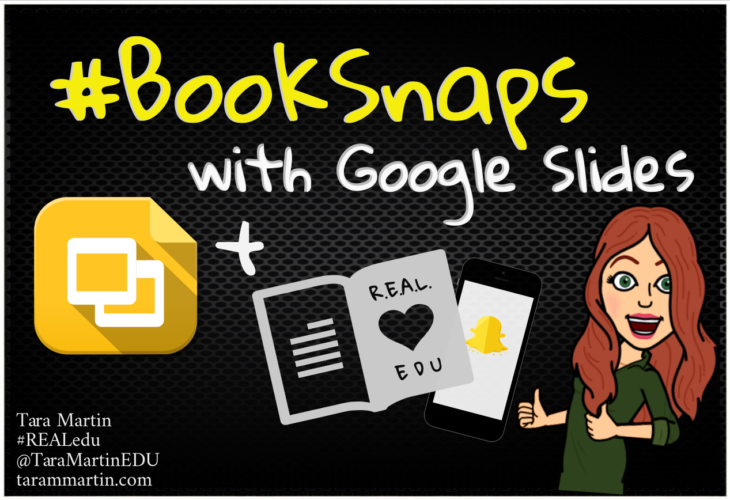#BookSnaps are digital, visual representations of learning that showcase student voice and choice. #BookSnaps can be used at any grade level and for any subject. With that in mind, I would like to introduce a collaborative way to share and curate #BookSnaps using Google Slides.
#BookSnaps in Google Slides
When creating #BookSnaps in Google Slides, students can pull images from the web, create their own pictures via selfies, add text and annotation, think bubbles, Bitmojis, emojis, and they can collaborate with others. It’s a “student-voice” WIN, for sure!
It’s As Easy As 1-2-3
1 ) Set up a Google Slideshow with blank slides–one per student in your class.
2 ) Have each student take a slide, and create a BookSnap of their key takeaways from a novel or any content (subject) taught that day. (#MathSnaps, #ScienceSnaps, #PoetrySnaps, etc.) See the video below for details.
3 ) The great thing about Google Slides is it allows students to collaborate and comment on the work of others. After creating, have the students comment on one of the #BookSnaps and share their feedback about the content.
Digital Citizenship
Not only are students now peeking into the minds of their peers via #BookSnaps, but they are inquiring and engaging in critical feedback and rich discussions–digitally. No doubt, this activity might require a “digital citizenship” pep talk before and possibly during implementation, but where else will our students learn how to interact in such a way? It’s up to us to provide opportunities to teach them. I contend that any tool that engages students in providing and receiving authentic feedback takes learning to deeper levels of knowledge.
#BookSnaps via Google Slides provides a platform for students to express their learning with their classmates, and the whole show (of student-voice) can be shared easily via a “view only” link. The learning opportunities for collaborations across schools, grade levels, or even students around the globe are limitless.
A Few Suggestions For #BookSnaps via Google Slides
• Reflection after a lesson to check for understanding – #MathSnaps, #ScienceSnaps, #BookSnaps, etc.
• Independent Reading or Station Activity (#BookSnaps Reflections Station)
• Collaborative storytelling of key highlights from a novel or story
• A great alternative for “reading logs”
• Alternative “jigsaw” reading activity – Each person creates a #BookSnap of their learning
• 21st Century Book Reports – Give your #BookSnaps a voice. See #BookSnaps Speak here.
Publishing
After each student creates their #BookSnaps slide and comments, I love playing the slideshow of #BookSnaps for the kiddos as they are entering class the next day. I usually add music to it and have the snaps scrolling as they are unpacking or transitioning between classes. Publishing their work serves as a review and allows their thinking to be recognized by their peers.
I’ve seen teachers use their #BookSnaps Google Slideshow as a presentation during parent-teacher nights. We have also included them as a “view only” link in our school newsletters and featured them on our big screen in the front lobby of the schools to show our community how the students are processing their learning. The options are endless.
Access
Google Slides is available in most school districts around the world. However, any app that allows the user to take an image, use text or drawing for annotation, and create a visual representation with visuals, stickers, emojis and/or Bitmojis will serve as a #BookSnaps app.
Let’s Create #BookSnaps in Google Slides!
[video_page_section type=”youtube” position=”default” image=”” btn=”light” heading=”” subheading=”” cta=”” video_width=”1080″ hide_related=”false” hide_logo=”false” hide_controls=”false” hide_title=”false” hide_fullscreen=”false”]https://youtu.be/H9xssFGf32k[/video_page_section]
For more #BookSnaps resources, click here, or visit the “Resource” tab on tarammartin.com and #BookSnaps— column to the left. There are infographics, how-to videos, storytelling ideas, and so much more.
#BookSnaps Enrichment?
Try this Flipgrid Appsmash–#BookSnaps Speak!
It is an app-smash of Snapchat, Google Slides, Loom, and Flipgrid. Stellar for storytelling with #BookSnaps.


